The 2020 Mac Mini Unleashed: Putting Apple Silicon M1 To The Test
by Andrei Frumusanu on November 17, 2020 9:00 AM ESTBenchmarks: Whatever Is Available
As we’ve had very little time with the Mac mini, and the fact that this not only is a macOS system, but a new Arm64-based macOS system, our usual benchmark choices that we tend to use aren’t really available to us. We’ve made due with a assortment of available tests at the time of the launch to give us a rough idea of the performance:

One particular benchmark that sees the first light of day on macOS as well as Apple Silicon is Cinebench. In this first-time view of the popular Cinema4D based benchmark, we see the Apple M1 toe-to-toe with the best-performing x86 CPUs on the market, vastly outperforming past Apple iterations of Intel silicon. The M1 here loses out to Zen3 and Tiger Lake CPUs, which still seem to have an advantage, although we’re not sure of the microarchitectural characteristics of the new benchmark.
What’s notable is the performance of the Rosetta2 run of the benchmark when in x86 mode, which is not only able to keep up with past Mac iterations but still also beat them.
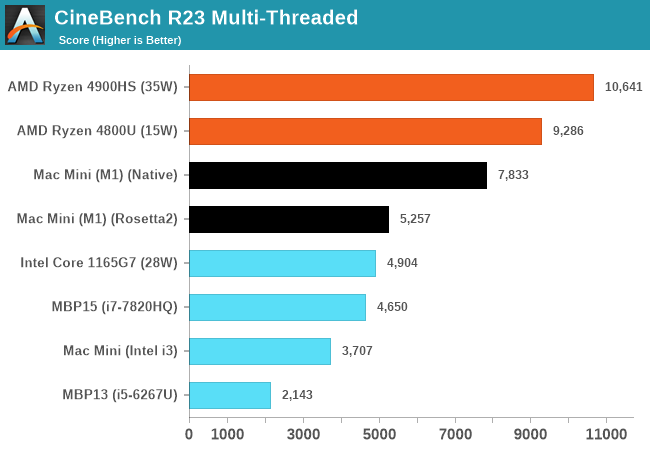
In the multi-threaded R23 runs, the M1 absolutely dominates past Macs with similar low-power CPUs. Just as of note, we’re trying to gather more data on other systems as we have access to them, and expand the graph in further updates of the article past publishing.
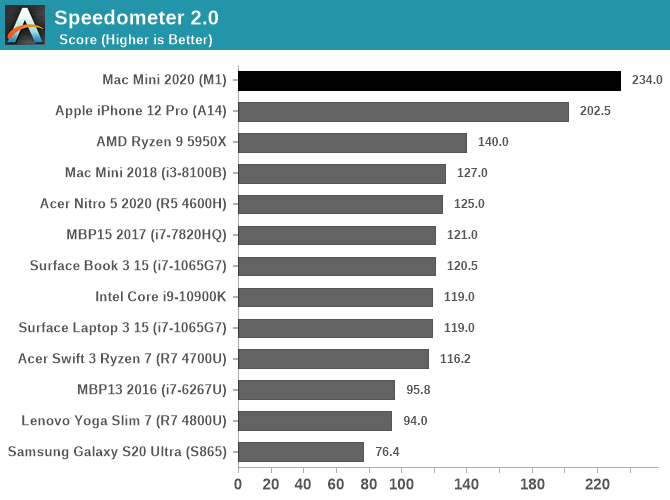
In browser-benchmarks we’ve known Apple’s CPUs to very much dominate across the landscape, but there were doubts as to whether this was due to the CPUs themselves in the iPhone or rather just the browsers and browser engines. Now running on macOS and desktop Safari, being able to compare data to other Intel Mac systems, we can come to the conclusion that the performance advantage is due to Apple’s CPU designs.
Web-browsing performance seems to be an extremely high priority for Apple’s CPU, and this makes sense as it’s the killer workload for mobile SoCs and the workload that one uses the most in everyday life.
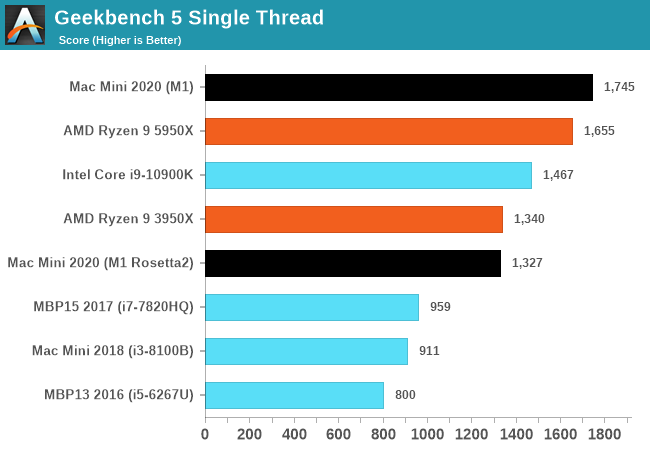
In Geekbench 5, the M1 does again extremely well as it actually takes the lead in our performance figures. Even when running in x86 compatibility mode, the M1 is able to match the top single-threaded performance of last generation’s high-end CPUs, and vastly exceed that of past iterations of the Mac mini and past Macbooks.
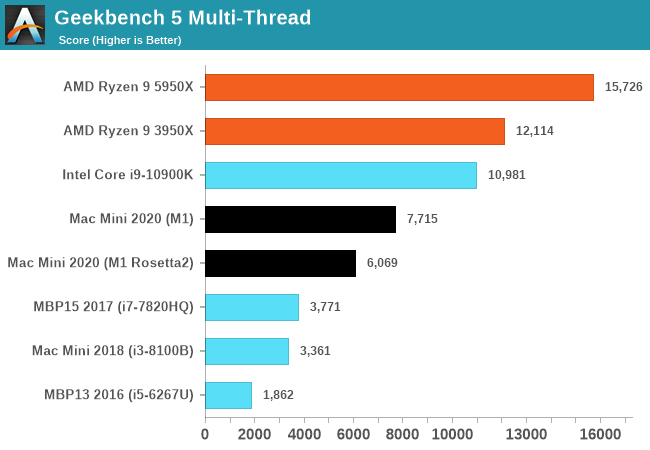
Multi-threaded performance is a matter of core-count and power efficiency of a design. The M1 here demolishes a 2017 15-inch Macbook Pro with an Intel i7-7820HQ with 4 cores and 8 threads, posting over double the score. We’ll be adding more data-points as we collect them.


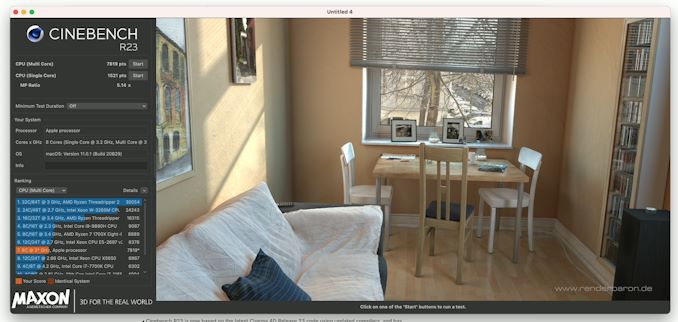








682 Comments
View All Comments
Kuhar - Wednesday, November 18, 2020 - link
You are wrong. This is literally Apple`s ONLY chip. So I can say it is the highest end chip.TEAMSWITCHER - Wednesday, November 18, 2020 - link
Not for long...Hrunga_Zmuda - Wednesday, November 18, 2020 - link
It's not a chip. It's an SOC. But be that as it may, Apple is literally using multiple chips right now, and they are going to be replacing their whole line right up to the Mac Pro. People think the Mac is small potatoes, but it's the equivalent of a Fortune 500 company. It just looks small because of how massive the iOS ecosystem is. They will easily make money just fine with the whole line updated to the M system. Why? Because Apple doesn't have to sell anything to other companies, so every single thing they make doesn't have to make money by itself. So the Mac Pro's processor might not make a profit itself, but the Mac Pro will.Spunjji - Thursday, November 19, 2020 - link
"Is" is not the same as "will be"Reading comprehension in the comments is not strong.
Spunjji - Tuesday, November 17, 2020 - link
Oh dear. Please don't blame the graphs - or, indeed, the author - when they show you something you didn't want to see.What you see here is extremely competitive performance, that AMD may well exceed when they get to 5nm - but they're not there just yet. For the end-user, what counts is what you can get.
AMD need to get their chips into more designs and with any luck they will; Intel can't bribe away a performance advantage like Zen 3 has forever.
markiz - Thursday, November 19, 2020 - link
For the end-user is not really relevant for this particular discussion, I think?I think the discussion is "philosophical" in nature, as in are there intrinsic differences and advantages of one over the other?
E.g., can AMD (or Intel, or Qualcomm) in lets say 2 years offer a SOC as efficeint and as performant as apple can?
So as to say, is it a matter of time, is that time reasonable, or is it unsurmountable?
If I knew Qualcomm will offer a comparable snapdragon in 2022 (and MS sorts the emulation issues), or if AMD will offer comparable chip in 2022, i am good, and would pick from a wastly wider pool of hw designs of windows ecosystem. I like convertibles.
If on the other hand this time frame is larger, or if they will never offer either the efficiency or performance, I would switch to apple all be damned.
BushLin - Thursday, November 19, 2020 - link
..."can AMD (or Intel, or Qualcomm) in lets say 2 years offer a SOC as efficeint and as performant as apple can?"AMD have a comparable chip available now in performance and power, been out for ages and it's in the benchmarks. If you need your system to do some actual work, the 4800U is a better chip. If your workload doesn't scale to many threads and the software is available for the new ARM platform then Apple's silicon looks pretty sweet.
haghands - Tuesday, November 17, 2020 - link
Copeadt6247 - Tuesday, November 17, 2020 - link
The parts that beat the M1 have way more cores, a higher thermal budget, and higher clock.There's a lot of things to optimize for, and in its current form, Apple silicon doesn't offer solutions to all desktop workflows -- number of PCIe lanes comes to mind as a limitation.
AMD isn't wholly beaten, but they're also not playing the same game. The best thing to come out of this would be lighting a fire under AMD's butt.
But AMD will be chasing higher IPC and performance per watt, while Apple will be chasing higher core counts, higher thermal and power budget for desktop parts, and higher clocks. I'm hoping Intel is going to rebound with competitive parts in a couple years. Competition makes everyone better!
BushLin - Tuesday, November 17, 2020 - link
Er... Similar power drawn by old zen 2 design at 7nm which is giving better multithreaded performance.